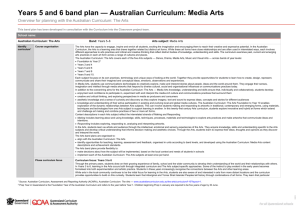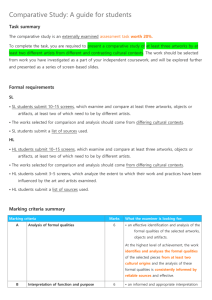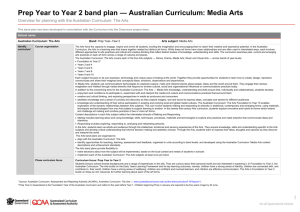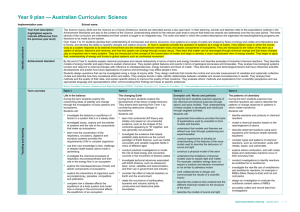Visual Arts - Queensland Curriculum and Assessment Authority
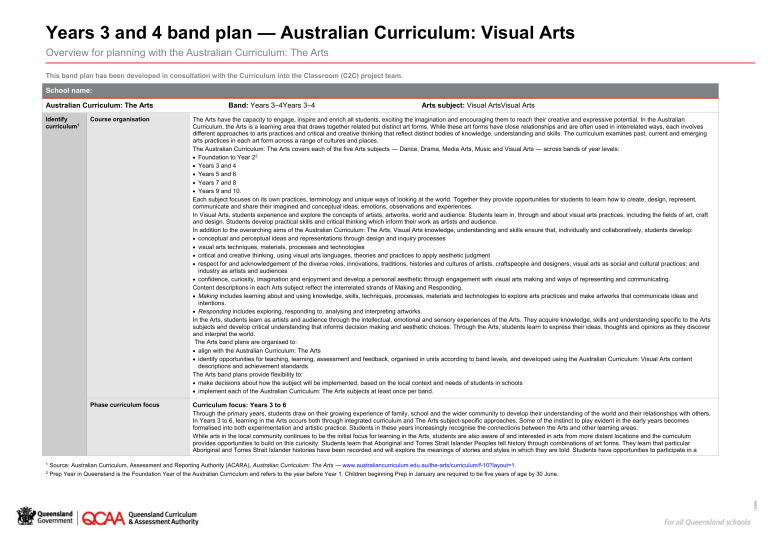
Years 3 and 4 band plan — Australian Curriculum: Visual Arts
Overview for planning with the Australian Curriculum: The Arts
This band plan has been developed in consultation with the Curriculum into the Classroom (C2C) project team.
School name:
Australian Curriculum: The Arts Band:
Years 3 –4Years 3–4
Arts subject:
Visual ArtsVisual Arts
Identify curriculum 1
Course organisation The Arts have the capacity to engage, inspire and enrich all students, exciting the imagination and encouraging them to reach their creative and expressive potential. In the Australian
Curriculum, the Arts is a learning area that draws together related but distinct art forms. While these art forms have close relationships and are often used in interrelated ways, each involves different approaches to arts practices and critical and creative thinking that reflect distinct bodies of knowledge, understanding and skills. The curriculum examines past, current and emerging arts practices in each art form across a range of cultures and places.
The Australian Curriculum: The Arts covers each of the five Arts subjects — Dance, Drama, Media Arts, Music and Visual Arts — across bands of year levels:
Foundation to Year 2 2
Years 3 and 4
Years 5 and 6
Years 7 and 8
Years 9 and 10.
Each subject focuses on its own practices, terminology and unique ways of looking at the world. Together they provide opportunities for students to learn how to create, design, represent, communicate and share their imagined and conceptual ideas, emotions, observations and experiences.
In Visual Arts, students experience and explore the concepts of artists, artworks, world and audience. Students learn in, through and about visual arts practices, including the fields of art, craft and design. Students develop practical skills and critical thinking which inform their work as artists and audience.
In addition to the overarching aims of the Australian Curriculum: The Arts, Visual Arts knowledge, understanding and skills ensure that, individually and collaboratively, students develop:
conceptual and perceptual ideas and representations through design and inquiry processes
visual arts techniques, materials, processes and technologies
critical and creative thinking, using visual arts languages, theories and practices to apply aesthetic judgment
respect for and acknowledgement of the diverse roles, innovations, traditions, histories and cultures of artists, craftspeople and designers; visual arts as social and cultural practices; and industry as artists and audiences
confidence, curiosity, imagination and enjoyment and develop a personal aesthetic through engagement with visual arts making and ways of representing and communicating.
Content descriptions in each Arts subject reflect the interrelated strands of Making and Responding.
Making includes learning about and using knowledge, skills, techniques, processes, materials and technologies to explore arts practices and make artworks that communicate ideas and intentions.
Responding includes exploring, responding to, analysing and interpreting artworks.
In the Arts, students learn as artists and audience through the intellectual, emotional and sensory experiences of the Arts. They acquire knowledge, skills and understanding specific to the Arts subjects and develop critical understanding that informs decision making and aesthetic choices. Through the Arts, students learn to express their ideas, thoughts and opinions as they discover and interpret the world.
The Arts band plans are organised to:
align with the Australian Curriculum: The Arts
identify opportunities for teaching, learning, assessment and feedback, organised in units according to band levels, and developed using the Australian Curriculum: Visual Arts content descriptions and achievement standards.
The Arts band plans provide flexibility to:
make decisions about how the subject will be implemented, based on the local context and needs of students in schools
implement each of the Australian Curriculum: The Arts subjects at least once per band.
Phase curriculum focus Curriculum focus: Years 3 to 6
Through the primary years, students draw on their growing experience of family, school and the wider community to develop their understanding of the world and their relationships with others.
In Years 3 to 6, learning in the Arts occurs both through integrated curriculum and The Arts subject-specific approaches. Some of the instinct to play evident in the early years becomes formalised into both experimentation and artistic practice. Students in these years increasingly recognise the connections between the Arts and other learning areas.
While arts in the local community continues to be the initial focus for learning in the Arts, students are also aware of and interested in arts from more distant locations and the curriculum provides opportunities to build on this curiosity. Students learn that Aboriginal and Torres Strait Islander Peoples tell history through combinations of art forms. They learn that particular
Aboriginal and Torres Strait Islander histories have been recorded and will explore the meanings of stories and styles in which they are told. Students have opportunities to participate in a
1 Source: Australian Curriculum, Assessment and Reporting Authority (ACARA), Australian Curriculum: The Arts
— www.australiancurriculum.edu.au/the-arts/curriculum/f-10?layout=1.
2 Prep Year in Queensland is the Foundation Year of the Australian Curriculum and refers to the year before Year 1. Children beginning Prep in January are required to be five years of age by 30 June.
Teaching and learning
Band description
Achievement standard
Content descriptions
Viewpoints 3
variety of Aboriginal and Torres Strait Islander art forms that are publicly available for broader participation in their community. Students may also extend their cultural expression with appropriate community consultation and endorsement.
Students also study artworks which represent Aust ralia’s connections with other places, the effects of these interconnections and the factors that affect people’s knowledge and opinions of other places.
During these years of schooling, students’ thought processes become more logical and consistent, and they gradually become more independent as learners. Students talk about changes in their own thinking, performance or making, giving reasons for their actions and explaining and demonstrating their organisation of ideas. They begin to recognise, appreciate and value the different ways in which others think, act and respond to artworks and consider how practices in the Arts may be enacted and sustained.
In Years 3 and 4, learning in Visual Arts builds on the experience of the previous band. It involves students making and responding to visual arts independently, and collaboratively with their classmates and teachers.
Students extend their awareness of how and why artists, craftspeople and designers realise their ideas through different visual representations, practices, processes and viewpoints. They explore and experiment with a greater diversity of materials, techniques and technologies. They further enhance their perceptual skills by observing closely the visual detail of the world around them and applying these observations through different practical applications of art making. Through observational, imaginative, cognitive and sensory investigations, students become more knowledgeable and discerning about their practices as a visual artist. They can determine and execute an individual approach to a theme or subject matter. They explore, predict outcomes, test and explain their experimentation. They use different physical and digital materials and techniques, technologies and processes in visual arts forms, such as painting, drawing, sculpture, design and digital media.
As they experience visual arts, students draw on artworks from a range of cultures, times and locations. They explore the influences of Aboriginal and Torres Strait Islander Peoples, and of the
Asia region. Students learn about visual arts in their community. They also learn about visual arts from more distant locations that may be represented in their community. Students also explore different styles of art made by Aboriginal and Torres Strait Islander artists.
As they make and respond to visual artworks as artists and audiences, students explore visual representations based on their investigations of past histories, their heritage, and significant events and celebrations within their community. They make connections between their own artistic intentions and those of other artists, observing and identifying ideas and symbols used and adapted by artists in their artworks.
Students learn about safe visual arts practices. Their understanding of the roles of artists and audiences builds upon their experience from the previous band.
By the end of Year 4, students describe and discuss similarities and differences between artworks they make, present and view. They discuss how they and others use visual conventions in artworks. Students collaborate to plan and make artworks that are inspired by artworks they experience. They use visual conventions, techniques and processes to communicate their ideas.
For each unit:
Explore ideas and artworks from different cultures and times, including artwork by Aboriginal and Torres Strait Islander artists , to use as inspiration for their own representations
(ACAVAM110)
Use materials , techniques and processes to explore visual conventions when making artworks (ACAVAM111)
Present artworks and describe how they have used visual conventions to represent their ideas (ACAVAM112)
Identify intended purposes and meanings of artworks using visual arts terminology to compare artworks, starting with visual artworks in Australia including visual artworks of Aboriginal and
Torres Strait Islander Peoples (ACAVAR113)
The Australian Curriculum: The Arts outlines a range of viewpoints
— a collection of perspectives, lenses or frames through which artworks can be explored and interpreted. These perspectives, lenses and frames include the contexts, knowledge and evaluations students consider when both making and responding to artworks.
Visual Arts supports students to view the world through various lenses and contexts. They recognise the significance of visual arts histories, theories and practices, exploring and responding to artists, craftspeople and designers and their artworks. They apply visual arts knowledge in order to make critical judgments about their own importance as artists and audiences. Learning in the
Visual Arts helps students to develop understanding of world culture and their responsibilities as global citizens.
In both Making and Responding , students learn that meanings can be generated from different viewpoints and that these shift according to different world encounters. As students make, investigate or critique artworks as artists and audiences, they may ask and an swer questions to interrogate the artists’ meanings and the audiences’ interpretations. Meanings and interpretations are informed by contexts of societies, cultures and histories, and an understanding of visual arts practices. These questions provide the basis for making informed critical judgments about their own art and design works and other artworks they see, hear and interact with as audiences.
Key questions: Years 3 and 4
Context as artist and audience:
What clues communicate where the artwork was made?
What clues communicate when the artwork was made?
What clues communicate who made the artwork and why?
Knowledge as artist and audience:
What steps did the artist work through to develop this artwork?
How does the artist use visual conventions to communicate their ideas?
Evaluations and judgments as artist and audience:
How are these artworks similar and different?
How and why do artists collaborate?
What does the artwork mean?
3 Source: Australian Curriculum, Assessment and Reporting Authority (ACARA), Australian Curriculum: The Arts
— Visual Arts: Rationale and Learning in Visual Arts, www.australiancurriculum.edu.au/the-arts/visual-arts/rationale .
Years 3 and 4 band plan
— Australian Curriculum: Visual Arts
Overview for planning with the Australian Curriculum: The Arts
Queensland Curriculum & Assessment Authority
September 2015
Page 2 of 3
Unit overviews
The Australian Curriculum assumes that all students will study the five Arts subjects from
Foundation to the end of Year 6.
Schools decide which units of study per subject are to complete, and how and when. This band plan provides three potential units.
Unit 1 — Meaning in found objects
Students explore the communication of cultural meaning through found objects and surface manipulation.
Students will:
explore and identify purpose and meaning in sculptural artworks by Aboriginal artists, Torres Strait Islander artists and Asian artists, and use this as inspiration to develop their own artworks
experiment with visual conventions (plaster cast relief sculpture, mixed media, mould making, found objects, surface manipulation) in research and development of individual artworks following shared conditions
collaborate and plan the presentation of individual sculptures as a mural project
compare the unique qualities of three-dimensional artworks with two-dimensional artworks and use art terminology to communicate meaning.
This unit could complement the concepts taught in the Year 3
Science unit
What’s the matter?
in the Science exemplar Year plan by exploring the process of matter changing from liquid to solid in art processes, using plaster casting to make threedimensional sculptural forms. See: www.qcaa.qld.edu.au/ downloads/p_10/ac_science_yr3_plan.docx
.
Unit 2 — Diverse environments
Students explore the communication of diversity in the
Australian environment through the manipulation of visual language.
Students will:
explore and identify purpose and meaning of cultural symbolism in artworks by Aboriginal artists, Torres Strait
Islander artists and Asian artists to communicate relationships to environments and places
experiment with visual conventions and visual language to depict personal responses and qualities of environments
(printmaking techniques, colour relationships — warm/cool; application of materials
— harsh/gentle; spatial devices — flattened space/aerial perspective/ depth)
collaborate, plan and create a collection/exhibition of artworks to depict diversity in Australian environments and diversity in individual approach
compare contemporary artworks of Aboriginal artists, Torres
Strait Islander artists and other Australian artists that communicate personal experience with environments and natural landforms and use art terminology to communicate meaning.
This unit could complement the concepts taught in the Year 4
Geography unit Investigating sustainable uses of environments and resources in the Geography exemplar Year plan by exploring how places are characterised by their environments and the interconnection between people and environment, using expressive visual language in printmaking techniques. See: www.qcaa.qld.edu.au/downloads/p_10/ ac_geog_yr4_plan.docx
.
Unit 3
— Patterns in the playground
Students explore processes of abstraction and manipulation from realistic sources to develop individual expression through pattern, texture and shape in their local environment.
Students will:
explore artworks from Aboriginal artists, Torres Strait
Islander artists and Asian artists which represent country through symbolic pattern and use this as inspiration to develop their own artworks
experiment with visual conventions (digital capture, rubbings, painting, collage) in research and development of a collaborative resolved artwork
represent ideas through the display of artwork and reflect on meaning through participation in art conversations and written reflections
compare artworks and use art terminology to communicate meaning.
General capabilities
Literacy Critical and creative thinking Personal and social capability Intercultural understanding
Cross-curriculum priorities
Aboriginal and Torres Strait Islander histories and cultures Asia and Australia’s engagement with Asia
Develop assessment
Assessment
The Year 3 to Year 6 The Arts:
Australian Curriculum in
Queensland
— assessment and reporting advice and guidelines brings together advice about assessment, making judgments and reporting in a single document: www.qcaa.qld.edu.au/downloads/p
_10/ac_arts_yr3-6.pdf
.
The assessment for each unit provides evidence of student learning and provides opportunities for teachers to make judgments about whether students have met the Australian Curriculum:
Visual Arts Years 3 and 4 achievement standard. Students should contribute to an individual assessment folio that provides evidence of their learning and represents their achievements. The folio should include a range and balance of assessments for teachers to make valid judgments about whether the student has met the achievement standard. It will gather evidence of their ability to:
describe and discuss similarities and differences between artworks they make and present describe and discuss similarities and differences between artworks they view
discuss how they use visual conventions in artworks
discuss how others use visual conventions in artworks collaborate to plan and make artworks that are inspired by artworks they experience
use visual conventions, techniques and processes to communicate their ideas.
Make judgments and use feedback
Consistency of teacher judgments
Make judgments of student achievements using the relevant achievement standards and task-specific standards.
Identify opportunities to moderate samples of student work at a school or cluster level to reach consensus and consistency.
Make consistent and comparable judgments by matching characteristics of the student work and qualities in the achievement standards.
Years 3 and 4 band plan
— Australian Curriculum: Visual Arts
Overview for planning with the Australian Curriculum: The Arts
Queensland Curriculum & Assessment Authority
September 2015
Page 3 of 3


